University of Texas at El Paso
The University of Texas at El Paso (UTEP) is a public research university in El Paso, Texas. It is a member of the University of Texas System. UTEP is the second-largest university in the United States to have a majority Mexican American student population (about 80%) after the University of Texas Rio Grande Valley.[7] It is classified among "R1: Doctoral Universities – Very high research activity."[8][9] The university's School of Engineering is the nation's top producer of Hispanic engineers with M.S. and Ph.D. degrees.[10]
 | |
Former names | Texas State School of Mines and Metallurgy (1913–1918) University of Texas Department of Mines and Metallurgy (1918–1921) Texas College of Mines and Metallurgy (1921–1948) Texas Western College (1948–1966)[1] |
|---|---|
| Motto | Scientia et Humanitas (Latin) |
Motto in English | "Knowledge and Liberal Education" |
| Type | Public research university |
| Established | April 16, 1913 |
Parent institution | University of Texas System |
| Accreditation | SACS |
Academic affiliations | |
| Endowment | $241.7 million (Fall 2017)[2] |
| President | Heather Wilson[3] |
Academic staff | 1,303 (Fall 2016)[4] |
Administrative staff | 1,519 |
| Students | 25,151[5] |
| Undergraduates | 21,341[5] |
| Postgraduates | 3,810[5] |
| Location | , , United States |
| Campus | Large City, 366 acres (1.48 km2) |
| Newspaper | The Prospector |
| Colors | Dark blue, orange, and silver accent[6] |
| Nickname | Miners |
Sporting affiliations | NCAA Division I FBS – C-USA |
| Mascot | Paydirt Pete |
| Website | www |
 | |
UTEP is home to the Sun Bowl stadium, which hosts the annual college football competition the Sun Bowl every winter.
The campus is one of the few places in the world outside of Bhutan or Tibet to have buildings created with the Dzong architectural style. It sits on hillsides overlooking the Rio Grande river, with Ciudad Juárez in view across the Mexico–United States border.
History
Early history
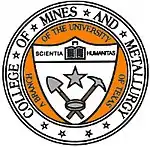
On April 16, 1913, SB 183 was signed by the Texas governor allocating funding for a new educational institution that would later become UTEP, making it the second oldest academic institution in the University of Texas system. The school officially opened on September 28, 1914, with 27 students in buildings belonging to the former El Paso Military Institute on a site adjacent to Fort Bliss on the Lanoria Mesa. The school was founded in 1913 as the State School of Mines and Metallurgy,[11] and a practice mineshaft survives on the campus. By 1916, enrollment had grown to 39 students, including its first two female students, Ruth Brown and Grace Odell.
On October 29, 1916, a devastating fire destroyed the main building of the school, prompting its relocation. In 1917, the new school facility was constructed on its present site above Mundy Heights at the Paso del Norte, with the land donated by several El Paso residents. In a period when United States architects were designing in styles adopted especially from Europe, Kathleen Worrell, wife of the university's dean, was attracted by photographs of the Kingdom of Bhutan in a 1914 issue of National Geographic magazine, which showed the dzong architecture style of its Buddhist monasteries.[12] The resemblances between the local terrain and mountainous features of Bhutan inspired her to propose designing early buildings of the mining school in the dzong style. Liking its distinctiveness, administrations have continued to choose that style for additional facilities, including the Sun Bowl football stadium and parking garages. Dzong architecture has characteristics such as sloping sides, markedly overhanging roofs, and bands of colored decoration.[13]
The University of Texas Board of Regents changed the name of the institution in 1919 first to the Department of Mines and Metallurgy and then to the College of Mines and Metallurgy of the University of Texas (TCM) in 1920. The school's name was changed again in 1949 to Texas Western College of The University of Texas (TWC).
Notable events at UTEP include the training in 1961 of the nation's first Peace Corps class, the construction of Sun Bowl Stadium in 1963, and the winning of the 1966 NCAA basketball tournament.
The University of Texas at El Paso
When the 60th Texas State Legislature designated the University of Texas as The University of Texas System in 1967, the name of the school was changed to The University of Texas at El Paso.[14] While the 1967 law designated "U.T. El Paso" as the school's official abbreviated name, the school is more commonly referred to by its trademarked name of "UTEP".[14] Known as the Miners since the school's opening in 1914, TCM's students painted a large "M" for Miners on the Franklin Mountains in 1923; this was later moved to a site adjacent to the Sun Bowl Stadium in the 1960s where it remains today.

The school has had achievements in academic and sports areas. In 1969, UTEP won the first of seven NCAA Men's Cross Country Championships. In 1974, UTEP's first doctoral degree program in Geological Sciences was approved. Also in 1974, UTEP won the first of seven NCAA Men's Indoor Track and Field Championships. In 1975 UTEP won both the NCAA Men's Outdoor and Indoor National Championships. UTEP is only one of a handful of universities to win at least 21 NCAA national championships in multiple sports.
The campus expanded in 1976 with the completion of the Engineering-Science Complex. That same year, the College of Nursing was founded. In 1977, the Special Events Center (now the Don Haskins Center) was built, featuring a 12,000-seat capacity for sporting events, live concerts, and other performances. An expansion of Sun Bowl Stadium followed in 1982, increasing its capacity to 52,000. The six-story University Library opened its doors to the public for the first time in 1984.
In 1988, Diana Natalicio became UTEP's first woman president. When she stepped down in August 2019, she was the longest-serving sitting president of a major public research university. In 1989, UTEP's second doctoral program was approved (in electrical engineering). Doctoral programs in computer engineering, psychology, and environmental science and engineering followed in 1991, 1993, and 1995, respectively. The university's cooperative pharmacy and nursing doctorate programs began in 1996 and 2000, respectively. A biological sciences doctorate program was started in 1997 and a history doctorate followed in 1999. Doctoral programs in international business, civil engineering, and rhetoric and composition were started in 2003.

In 1999, UTEP launched its MBA online degree program. It was designated as a Comprehensive Doctoral/Research-Intensive University by the Carnegie Foundation the following year. In 2002, the $11 million Larry K. Durham Sports Center opened and the Sam Donaldson Center for Communication Studies was established. The Academic Services and Biosciences buildings as well as the Engineering-Science complex in 2003. UTEP celebrated its 90th anniversary the next year with the Miners football team going to the Houston Bowl, and the men's basketball team made its 15th NCAA tournament appearance.
In August 2019, Heather Wilson, Ph.D., became UTEP's 11th president. She previously served as the Secretary of the U.S. Air Force.[15]
Academics and research
| Academic rankings | |
|---|---|
| National | |
| Forbes[16] | 547 |
| THE / WSJ[17] | 501-600 |
| U.S. News & World Report[18] | 304 |
| Washington Monthly[19] | 161 |
| Global | |
| ARWU[20] | 601-700 |
| THE[21] | 801-1000 |
| U.S. News & World Report[22] | 875 |
| Race and ethnicity[23] | Total | ||
|---|---|---|---|
| Hispanic | 86% | ||
| White | 5% | ||
| Foreign national | 4% | ||
| Black | 2% | ||
| Other[lower-alpha 1] | 2% | ||
| Asian | 1% | ||
| Economic diversity | |||
| Low-income[lower-alpha 2] | 65% | ||
| Affluent[lower-alpha 3] | 35% | ||
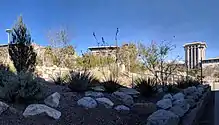
The University of Texas at El Paso is subdivided into nine colleges and schools, each of which offers a variety of degree programs including undergraduate, graduate, and post-graduate. UTEP offers 74 undergraduate degrees, 76 master's-level degrees, and 22 doctoral degrees.[24] UTEP follows a semester system with a spring, summer, and fall semester annually, along with a shorter wintermester in the month of January.[25]
UTEP offers the USA's only bilingual M.F.A. creative writing program.[26]
The university's research expenditure in fiscal year 2018 was $91 million.[24][27] UTEP is classified as an "R1: Research University (Highest research activity)" in the Carnegie Classification of Institutions of Higher Education.[9]
The National Science Foundation has designated UTEP as a Model Institution for Excellence, one of only six in the country. UTEP is one of only 11 universities nationwide to receive a $5 million Teachers for a New Era (TNE) research grant from the Carnegie Corporation.[28]
Hispanic Business magazine has twice ranked UTEP as the number one graduate engineering school for Hispanics. The National Action Council for Minorities in Engineering has called UTEP "a model for other engineering institutions who say that today's minority young people from low-income families can't succeed in a rigorous math- or science-based discipline."
In November 2012, it was announced Igor C. Almeida, professor of biological sciences at UTEP, had developed a fully protective vaccine against Chagas disease. UTEP also holds the rights to a patent (# 5,798,392) for the use of methanesulfonyl fluoride (MSF) as a central nervous system selective cholinesterase inhibitor for the treatment of Alzheimer's disease developed by Donald E. Moss in the department of psychology. A Phase I human clinical trial of MSF as a potential treatment for Alzheimer's disease was successfully completed in Germany.[29]
UTEP's art gallery, the Stanlee and Gerald Rubin Center for the Visual Arts, specializes in site-specific art installations and exhibitions by renowned artists, which have included in the past Teresa Margolles, Tania Candiani, and Rafael Lozano-Hemmer. Under the leadership of its current director, Kerry Doyle, the Rubin Center has been recognized with grants and awards by the Texas Commission on the Arts, the National Endowment for the Arts, the Andy Warhol Foundation for the Visual Arts, the Lannan Foundation, the Leonard Nimoy Foundation, and others.[30]
In June 2023 the university was placed on Warning status by its educational accreditor, the Southern Association of Colleges and Schools, after the accreditor's board found significant non-compliance with its standards for full-time faculty employment, program availability, qualified administrative staff and academic program coordination.[31]
Campus architecture
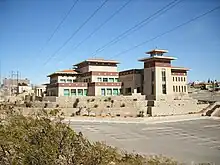
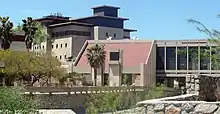

In 1916, only two years after the school opened, the original campus buildings were destroyed in a fire. The school was rebuilt on its present site in 1917. Kathleen Worrell, the wife of the school's first dean Steve H. Worrell, had seen pictures of Bhutanese buildings in an April 1914 issue of National Geographic. Noting the similarity of mountainous Bhutan (which is in the Himalayas) to the location of the campus, she suggested the new buildings be in the style of Bhutanese dzongs (monastic fortresses), with massive sloping walls and overhanging roofs. This idea was enthusiastically accepted by all.
Prominent El Paso architect Henry Trost designed the first four buildings. All buildings since then have followed this style, including a fifth by Trost in 1920, and three more by his firm in 1933–1937. While the early structures only copied the general appearance of a dzong, recent buildings incorporate internal elements of the dzong form as well.
The kingdom of Bhutan has honored UTEP's adoption of their country's style. Prince Jigyel Ugyen Wangchuk has visited the campus, and in 2009 the Kingdom presented UTEP with a hand-carved wooden temple to be erected on the campus.[32]
The Himalayan style of UTEP's campus made it an appropriate site for the Chenrezig Himalayan Cultural Center of El Paso, a Tibetan Buddhist facility.
School colors and logo
Since the school was established as a department of the main branch of the University of Texas at Austin, the school's colors were originally orange and white. However, in the early 1980s, Columbia blue was added so now the official colors are orange, white, and blue. When the new UTEP athletic department logo was introduced in the fall of 1999, a darker hue of blue was incorporated into the logo, as well as a silver accent to go with the customary orange.[33]
Athletics
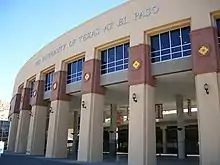
UTEP was the first college in the American South to integrate its intercollegiate sports programs. This change was made in the 1950s. When Don Haskins became basketball coach in 1961, he aggressively recruited black players. In 1966, Haskins' Miners won the NCAA basketball championship, defeating an all-white Kentucky team in the final game. At a time when many claimed black players lacked the mental and emotional "necessities" to compete at a high level, Haskins put his usual starting players in the championship game. They were the first all-black team to start in a game at that level. This story was retold in Haskins' autobiography Glory Road (2005) and in the 2006 film Glory Road. Haskins coached his entire career at UTEP and compiled a 719–353 record with only five losing seasons. He was inducted into the Basketball Hall of Fame in 1997, and the special events center was renamed the Don Haskins Center. He retired from coaching in 1999, and died in 2008.[34] The entire 1966 UTEP team was inducted into the Hall of Fame in 2007.[35]
In 1968, the UTEP track & field program revoked the scholarships of eight black athletes after they boycotted a meet at Brigham Young University in protest of perceived racism at BYU and in the Church of Jesus Christ of Latter-day Saints of the era. This included future gold medal winner and world record long jump holder Bob Beamon, who would briefly return to the school after the incident but not graduate.[36] The coach at the time later regretted his actions, and felt that he and the school acted hastily.[37]
UTEP's sports programs have won a total of 21 NCAA Division I national championships.[38] UTEP is tied for 10th overall among schools in Men's Sports Division I championships.
- Men's basketball: 1 (1966; the first of two NCAA men's basketball titles won by a university from the state of Texas)
- Men's cross country: 7 (an eighth title was vacated by the NCAA following the championship)
- Men's indoor track & field: 7
- Men's outdoor track & field: 6
UTEP owns the two largest venues in El Paso, Texas:
- Sun Bowl Stadium, seating capacity 51,500, opened its doors in 1963 and is the home to the UTEP football team and to the annual Sun Bowl game.
- Don Haskins Center, seating capacity 12,000, was built in 1976 and is primarily used by the men's and women's basketball teams. It is also known as "The Bear's Den" as well as "The Don." The arena is also used for concerts by mainstream artists.
- University Field (UTEP), seating capacity 500, was built in 1991 and hosts the women's soccer team.
- Kidd Field, seating capacity 15,000, home of UTEP Track and Field teams.
In 2005, UTEP moved to Conference USA from the Western Athletic Conference.[39]
On December 10, 2012, it was announced that Sean Kugler would be taking over as the new UTEP football coach.[40]
In 2010, Tim Floyd became the head basketball coach.[41] He was a protege of Haskins and is a former coach at the University of New Orleans, the NBA's Chicago Bulls and New Orleans Hornets, and the University of Southern California. Floyd retired in 2017 due to recurring health issues[41] and was succeeded by Rodney Terry, former head coach at CSU Fresno (Fresno State).[42]
Pickaxe hand symbol

This hand symbol represents the traditional tool used by miners, the pickaxe, and is similar to the shaka sign and the letter Y in American sign language. This gesture is made by UTEP fans when UTEP players are shooting free throws at basketball games, or any time UTEP kicks off at a football game. It originated during a cheer camp by the UTEP cheerleading squad during the early 1980s.[43]
Nickname
The first reference to the nickname "Miners" is found in the February 1919 (volume 1, number 1) issue of the Prospector, the school's student newspaper. However, an earlier reference can be found in the handwritten bill (Senate Bill 183) that established the school in 1913, where the author, State Senator Claude Hudspeth, mistakenly wrote "Miners" instead of "Mines," and thus referred to the school as the "State School of Miners and Metallurgy." It is presumed the nickname "Miners" came from the fact the school was founded as the "State School of Mines and Metallurgy." In doing research on this project, early mention of "Ore Diggers" and "Muckers" for the nickname was found, but nothing to determine if the name "Miners" was voted upon by the student body, or if a faculty member, John W. (Cap) Kidd, chose the name. Kidd was a big booster of athletics, especially football, and in 1915, when funds were lean at the school, Kidd donated $800 to equip the football team, though there is no evidence other than anecdotal he contributed this amount. He also assisted with coaching, although he was not the head coach. The present track facility on campus, Kidd Field, bears Cap Kidd's name.
School songs
"The Eyes of Texas" was adopted by the 1920 student body after the song had been "declared the school anthem for the University of Texas at Austin".[44][45]
UTEP's fight song, "Miners Fight", was also borrowed from the Austin campus.
With the permission of the estate of Marty Robbins, the UTEP Music Department in the late 1980s wrote new words to the melody of his Grammy Award-winning country-western hit "El Paso". This gave UTEP a fight song all its own, to a tune recognized across the nation.[46]
Rivalries
New Mexico State University: UTEP has a strong rivalry with New Mexico State University, known as "The Battle of I-10". UTEP and NMSU are just over 40 miles apart.
Notable people

Faculty
- Zuill Bailey, professor of cello, professional cellist
- Steven Best, professor of philosophy and co-founder of the North American Animal Liberation Press Office
- Andy Cohen, Major League Baseball second baseman who coached university team for 17 years
- Jorge Gardea-Torresdey, chemistry professor and nanoparticle researcher
- Laurie Ann Guerrero, writer and Texas Poet Laureate
- John Haddox, philosopher and Latin-Americanist
- Anna Jaquez, art professor
- Jorge López, physics professor and educator
- Urbici Soler y Manonelles, Spanish sculptor
- Benjamin Alire Sáenz, writer
- Ellwyn R. Stoddard, professor emeritus of anthropology and sociology
- Rachelle Thiewes, American jeweler
Alumni
- F. Murray Abraham – actor
- Ana Alicia – actress
- Tobi Amusan – Nigerian track and field athlete
- Nate Archibald – professional basketball player
- Jim "Bad News" Barnes – professional basketball player
- Bob Beamon – track and field athlete and Olympian
- Kevin Belcher – professional football player
- Derrick Caracter – professional basketball player
- Cortney Casey – professional mixed martial artist
- Asnage Castelly, Olympic wrestler
- Sam Donaldson – American reporter and news anchor
- Fred Carr – professional football player
- Alfredo Corchado – Mexican-American journalist
- Oniel Cousins – professional football player
- Alicia Cuarón – Mexican-American educator and human rights activist
- George Daney – professional football player
- James Davidson – professional football player
- Antonio Davis – professional basketball player
- Quintin Demps – professional football player
- Tim Hardaway – professional basketball player
- Ed Hochuli - American football official
- Aaron Jones – professional football player
- Emmanuel Kipkurui Korir – Kenyan a middle-distance runner and Olympic athlete
- Mia Khalifa – internet celebrity, former pornographic film actor, sports commentator
- Jeffrey Martin – CEO and chairman of Sempra Energy
- Suleiman Nyambui, Tanzanian track athlete and Olympian
- Sam Simon – playwright, consumer advocate
- Tony Tolbert – professional football player
Gallery
 College of Engineering Department area
College of Engineering Department area Physical Science Building
Physical Science Building Library
Library Centennial Plaza
Centennial Plaza
Notes
- Other consists of Multiracial Americans & those who prefer to not say.
- The percentage of students who received an income-based federal Pell grant intended for low-income students.
- The percentage of students who are a part of the American middle class at the bare minimum.
References
- "History".
- "The University of Texas System Smartbook" (PDF). University of Texas System. Retrieved April 2, 2018.
- "Heather Wilson named president of UT El Paso". www.utsystem.edu. April 2, 2019. Retrieved May 10, 2020.
- "First-Time Students Push UTEP to New Fall Enrollment Record". University of Texas at El Paso. June 20, 2013. Archived from the original on September 23, 2013. Retrieved February 14, 2014.
- "UTEP-Fall-Enrollment-Increases-for-20th-Consecutive-Year". University of Texas at El Paso. Retrieved September 18, 2018.
- https://www.utep.edu/university-communications/resources/graphic-identity-guide.html |title=The University of Texas at El Paso / Graphic Identity Guide |
- "Archived copy" (PDF). Archived from the original (PDF) on August 22, 2016. Retrieved September 10, 2016.
{{cite web}}: CS1 maint: archived copy as title (link) - "Carnegie Classifications Institution Lookup". carnegieclassifications.iu.edu. Center for Postsecondary Education. Retrieved July 19, 2020.
- "UTEP Attains National Research Top Tier Ranking". The University of Texas at El Paso. Retrieved January 9, 2019.
- "UTEP tops national rankings for producing Hispanic engineers". The University of Texas System. April 3, 2013. Retrieved July 26, 2013.
- "Official Names; UTEP Encyclopedia". Archived from the original on March 12, 2014. Retrieved April 19, 2015.
- Napoli, Lisa (October 16, 2011). "El Paso: Bhutan's Kingly Style Reflected in UTEP Architecture". Los Angeles Times. Retrieved December 5, 2012.
- University History". UTEP Handbook of Operations, University of Texas, El Paso. Archived from the original on July 23, 2011. Retrieved September 1, 2011.
- "Official Names". UTEP Encyclopedia. December 1, 2014. Archived from the original on March 16, 2015. Retrieved January 31, 2015.
- "Heather Wilson named president of UT El Paso". The University of Texas System. April 2, 2019. Retrieved August 16, 2019.
- "Forbes America's Top Colleges List 2023". Forbes. Retrieved September 22, 2023.
- "Wall Street Journal/Times Higher Education College Rankings 2022". The Wall Street Journal/Times Higher Education. Retrieved July 26, 2022.
- "2023-2024 Best National Universities". U.S. News & World Report. Retrieved September 22, 2023.
- "2022 National University Rankings". Washington Monthly. Retrieved September 13, 2022.
- "ShanghaiRanking's Academic Ranking of World Universities". Shanghai Ranking Consultancy. Retrieved February 25, 2023.
- "World University Rankings 2024". Times Higher Education. Retrieved September 27, 2023.
- "2022-23 Best Global Universities Rankings". U.S. News & World Report. Retrieved February 25, 2023.
- "College Scorecard: University of Texas at El Paso". United States Department of Education. Retrieved May 24, 2022.
- "About UTEP". University of Texas at El Paso. Retrieved December 13, 2018.
- "Academic Calendar". University of Texas at El Paso. Retrieved December 13, 2012.
- Gleibermann, Erik (November 2, 2017). "Seeking a Voice, via a Bilingual M.F.A., in Writing and in Life". The New York Times. The New York Times. Retrieved June 23, 2019.
- "Table 20. Higher education R&D expenditures, ranked by FY 2018 R&D expenditures: FYs 2009–18". ncsesdata.nsf.gov. National Science Foundation. Retrieved July 20, 2020.
- "Carnegie Corporation Names New Teachers Program Grantees". Philanthropy News Digest. Retrieved December 20, 2012.
- Moss, DE; Fariello, RG; Sahlmann, J; Sumaya, I; Pericle, F; Braglia, E (2013). "A randomized phase I study of methanesulfonyl fluoride, an irreversible cholinesterase inhibitor, for the treatment of Alzheimer's disease". Br J Clin Pharmacol. 75 (5): 1231–1239. doi:10.1111/bcp.12018. PMC 3635594. PMID 23116458.
- "ABOUT". www.utep.edu. Retrieved October 4, 2020.
- "Disclosure Statement Regarding the Status of THE UNIVERSITY OF TEXAS AT EL PASO" (PDF). Southern Association of Colleges and Schools. Retrieved September 11, 2023.
- Soltero, Ed (January–February 2009). "UTEP's Bhutanese Campus Goes Modern". Texas Architect.
- "History & Spirit - The University of Texas at El Paso". alumni.utep.edu. Retrieved October 2, 2021.
- "UTEP's Haskins resigns after 38 years on job". DeseretNews.com. August 25, 1999. Retrieved April 26, 2019.
- "The Naismith Memorial Basketball Hall of Fame :: 1966 Texas Western". www.hoophall.com. Retrieved April 26, 2019.
- Olsen, Jack. "In An Alien World". Sports Illustrated Vault | SI.com.
- Boylan-Pett, Liam (October 18, 2018). "Months before his famous jump, Bob Beamon got kicked off his college track team for protesting racism".
- "Schools with the Most NCAA Championships". Archived from the original on June 3, 2007.
- Athletics, UTEP (March 12, 2019). "UTEP set for Conference USA Tournament". KTSM. Retrieved April 26, 2019.
- "UTEP hires Sean Kugler as coach". ESPN. December 10, 2012. Retrieved December 10, 2012.
- "Health scare, loss of fun fueled Tim Floyd's retirement from UTEP basketball in November". El Paso Times. Retrieved April 26, 2019.
- Pascoe, Bruce. "First-year coach Rodney Terry has faith — and facilities — to rebuild UTEP tradition". Arizona Daily Star. Retrieved April 26, 2019.
- "The University of Texas at El Paso - UTEP Alumni Association History and Spirit". UTEP Alumni Association History and Spirit.
- "Spirit and Traditions – University of Texas at El Paso". utexas.edu. Archived from the original on February 21, 2012. Retrieved January 5, 2014.
- "Songs – University of Texas at El Paso". utexas.edu. Archived from the original on September 7, 2008. Retrieved January 5, 2014.
- "School Songs – University of Texas at El Paso". Archived from the original on February 22, 2014. Retrieved January 5, 2014.
